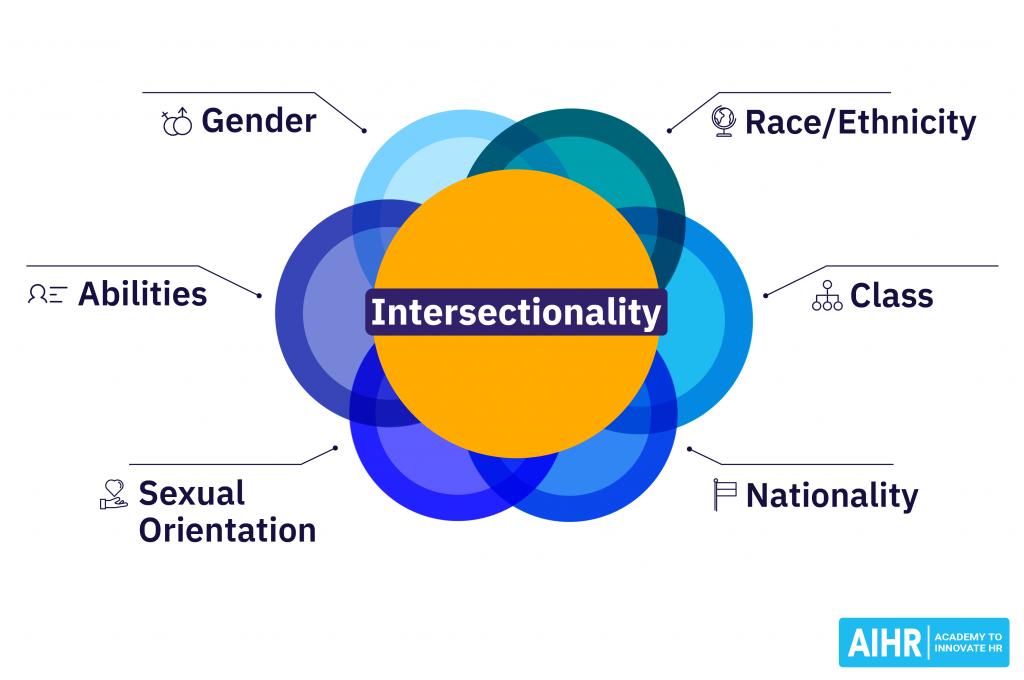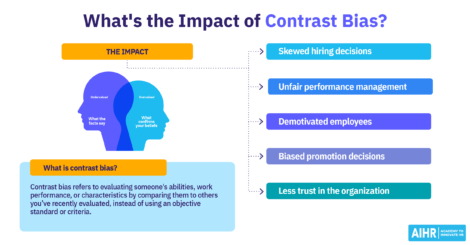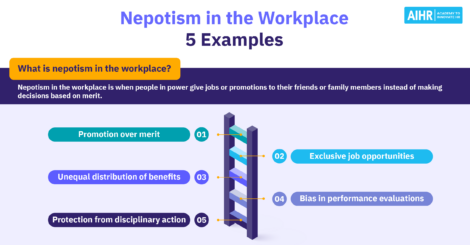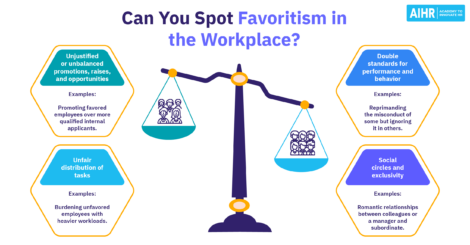Intersectionality in the Workplace: What HR Needs to Know

Companies that are serious about diversity, equity, inclusion and belonging are the ones that have happy and productive employees. And if your organization wants to be truly inclusive, you need to understand what intersectionality in the workplace means and how you can embrace it. Let’s dive in.
Contents
What is intersectionality in the workplace?
What are examples of intersectionality?
Why you need to pay attention to intersectionality in the workplace
What HR can do to embrace intersectionality in the workplace
What is intersectionality in the workplace?
Professor Kimberlé Crenshaw coined the term intersectionality in 1989 to explain how race, ethnicity, class, gender, sexual orientation, disability, religion, age, and other characteristics intersect and overlap with each other and affect the experiences of marginalized individuals or groups.
Intersectionality in the workplace centers on understanding intersectionality and how the interplay of identities affects certain individuals and groups in the context of work. Then, it incorporates this understanding into policies and practices from recruitment to onboarding to training and leadership. The goal is also to ensure that employees have opportunities to discuss these issues in a transparent way to eradicate discrimination and create a fair, inclusive workplace.
The concept of intersectionality has recently skyrocketed to the forefront of conversations and received much criticism over the years.
Many argue that the problem disappears once laws are changed or created that remove any bias relating to these individual characteristics that people hold. But as Crenshaw rightly notes, the 1965 Civil Rights Act in America did not eradicate racism or the racial wealth gap that we continue to see today. Similarly, reinstating women’s rights over the years has not ended sexism or misogyny.
She argues that discrimination remains because the modern systems our society is built on were predominantly built by white men and therefore were infused with racism, sexism, and other forms of discrimination.
What are examples of intersectionality in the workplace?
An example of intersectionality is that women are reported to earn $0.83 for every $1.00 men make. However, women of color are at an even greater disadvantage. Black women were paid 64%, while Hispanic women were paid 57% of what white non-Hispanic men were paid in 2020.
This shows that although they’re all categorized within the same gender, women of different races and ethnicities have different workplace experiences and may face more inequality.
Another example of intersectionality is in US companies with 100+ employees, the proportion of Black men in managerial positions rose slightly from 3% to 3.3% between 1985 and 2014. White women saw more significant gains of 22% to 29% between 1985 and 2000. However, this percentage has not risen since then. This suggests that management positions continue to be dominated by White men.
Furthermore, people of color who also have a disability might experience even more layers of bias when applying for jobs and in the workplace.
Another example of intersectionality in the workplace is neurodiversity and gender. Professor Ludmila N. Praslova recounts her own experience with gender inclusion: “…tweaking the system to include women did nothing for neurodivergent women — I was still unincludable and on the margin.”
Why you need to pay attention to intersectionality in the workplace
It’s imperative to be mindful of intersectionality and educate yourself and your organization on it in the workplace for several reasons.
To build a truly inclusive and equitable workplace
Intersectionality helps you shape your company initiatives to account for the varying experiences of your employees. Therefore, it enables you to effectively fight bias and discrimination.
Without recognizing intersectionality, it’s impossible to build an inclusive workplace, and this is vital to ensure a positive employee experience where everyone feels welcomed, safe, heard, supported, and respected regardless of their different characteristics such as race, ethnicity, class, gender, sexual orientation, disability, or religion.
In an inclusive and equitable workplace, employees feel confident to voice opinions and concerns without fear of reprimand, alienation, or victimization. They trust that the business leaders will listen to and act on their feedback.
To become an employer of choice
More and more people, particularly Millennials and Gen Z, are actively looking to work for a company that is committed to DEIB. They don’t want to feel excluded, but also because they don’t want anyone else to feel excluded.
It’s no longer enough to offer the best annual salary in your industry or an attractive benefits package. In fact, candidates are assessing organizations on so much more. Hence, today’s job seekers prioritize employers who demonstrate inclusion as one of their values. A McKinsey survey found that 39% of those surveyed decided not to take a job because they perceived the organization lacked an inclusive environment.
Our world and, therefore, our workplaces are becoming increasingly diverse. This has led to many employees feeling like outsiders because of how they’re treated or their subtle experiences. And when someone feels excluded or like they don’t belong, they are far less likely to feel engaged and happy at work and committed to the organization.
To improve employee wellbeing
A workplace that pays attention to intersectionality and weaves this into policies and practices is making an active effort to improve the lives of all employees. This undoubtedly contributes to the overall improvement of employee wellbeing.
When employees are happy and healthy at work, they can perform at an optimum level, prevent the onset of health problems related to anxiety and stress, and take better care of the people around them.
To boost results
Research has shown that organizations with greater ethnic and racial diversity are 35% more likely to achieve higher results. In comparison, organizations with gender diversity are 15% more likely to exceed the industry average.
While your primary concern should be to create a diverse, inclusive, and equitable workplace, the side benefit is that employees gain an environment that helps them bring their A-game and thrive. Therefore, understanding diversity and intersectionality in the workplace should be a priority across all organizations.
What HR can do to embrace intersectionality in the workplace
There are several steps HR can take to understand and embrace intersectionality in the workplace. That way, you can create a more inclusive environment for everyone.
1. Recognize intersectionality at different stages of the employee life cycle
What intersectionalities are present in your candidate pool? What obstacles do your candidates and employees face during the entire employee life cycle, from attraction to recruitment, retaining, and leaving the organization?
It’s important to realize that intersectionality affects the entirety of the employee life cycle. Therefore, you must consider it in all your current policies and day-to-day practices. Understanding intersectionality and spotting it is the first step to embracing it.
2. Continuously review your policies, processes, programs, and initiatives
What do your organization’s current policies and initiatives mean for different intersectionalities? For example, a mentoring program aimed at employees of a certain race or ethnicity will affect employees of different genders and employees with disabilities differently. It’s important to be aware of this and resist automatically adopting a one-size-fits-all approach.
According to Harvard Business Review, initiatives that are effective in increasing diversity include:
- Targeted college recruitment
- Self-managed teams
- Mentoring
- Diversity managers.
Let’s look at what you can do to consider intersectionality in your organization’s practices and processes.
Recruitment
For example, HR could work with managers to ensure college recruitment programs target women and people from underrepresented groups. That would increase your chances of recruiting strong, qualified candidates from these groups.
Findings show that after five years of a company implementing a college recruitment program that targets female employees, the percentage of White, Black, Hispanic, and Asian-American women in managerial positions increases by around 10% on average.
Onboarding
HR can also provide an onboarding experience to new employees that makes them feel welcome and comfortable and sets a precedent for their time at the company. In addition, make your policies on inclusion clear.
Explain how new hires can help create an inclusive environment that is void of discrimination. Cover the measures that would be taken if they were to be mistreated or if they were to mistreat anyone else. Establishing a tone of inclusion from day one helps lay a positive foundation for your employee’s entire life cycle at the organization.
Self-managed teams
Creating more opportunities for employees in various roles and functions to collaborate on projects as equals in self-managed teams helps increase contact among different groups of people and break down stereotypes. Rotating management trainees can also increase this type of contact.
Internal mobility
Promoting and retaining talent from within the company is one of the best ways to create a more diverse and inclusive environment at all levels. That’s why facilitating internal mobility through training, upskilling, and mentoring programs is critical.
Diversity managers
Diversity managers also appear to be effective in reducing bias. When people know they may have to explain their decision-making process, this social accountability means they are less likely to make biased decisions. Companies who do appoint diversity managers see between a 7% and 18% increase in underrepresented groups in management after five years.
3. Actively seek different perspectives and feedback
While collecting feedback on your existing policies and initiatives to embrace intersectionality, consider sending out surveys or conducting one-on-one interviews with employees from all underrepresented groups. That way, you can get their views on how the organization can improve and create a fair, inclusive environment for all.
You might assume that “all women” hold a certain opinion while “all LGBTQ+” believe something else, but this is often not the case – everyone experiences the world slightly differently.
A confidential survey may be the best way to offer your employees the chance to express their opinions anonymously. It’s equally important to encourage employees not to hold back. Make it clear that there will be no potential negative consequences for speaking up.
Sample questions might include:
- “This organization offers an environment where I am free to express ideas, opinions, and beliefs openly.”
- “I feel comfortable talking to my manager and colleagues about my background and cultural experiences.”
Respondents can rate how much they agree or disagree with the statement on a scale of 1-10 and offer space for any additional comments.
Use your findings to determine what needs improving. Then, draw up an action plan in order of priority to help you achieve your desired outcomes.
4. Build a functional DEI dashboard
The right DEI dashboard will allow you to filter on different options and see various statistics that you wouldn’t otherwise be able to see.
For example, how does your turnover rate of Black female employees under 30 compare to that of White female employees? Who is being hired, and who is being rejected during the current recruitment process? Are there equal opportunities for advancement for people of different backgrounds? Naturally, it’s essential to factor in the overall size of your organization when looking at these metrics.
Most biases in the workplace are unconscious, which makes them challenging to stamp out. Hence, measuring everything is essential. New policies and initiatives addressing intersectionality will not be effective unless you have meaningful metrics to track your efforts and results. Using HR KPIs can help foster a more inclusive workplace.
5. Educate yourself
The final step in embracing intersectionality in the workplace is to educate yourself on issues that affect marginalized groups of employees at work.
Speak to people and actively listen, as mentioned above. Research new programs and initiatives. Stay on top of emerging issues and statistics in the media. Look at what your competitors are doing to create a more inclusive work environment.
Making the effort to build your knowledge around how different aspects of people’s identities work together and shape their work experiences will translate into effective inclusion initiatives.
A final word
In summary, embracing intersectionality in the workplace means acknowledging the intersecting identities of your employees and their different experiences, understanding how this impacts their work-life, and using these insights to create an inclusive work environment. Such an intersectional approach leads to happier, more engaged, and productive employees.
Weekly update
Stay up-to-date with the latest news, trends, and resources in HR
Learn more
Related articles
Are you ready for the future of HR?
Learn modern and relevant HR skills, online













